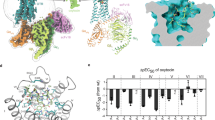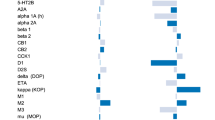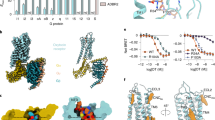Abstract
CYANATE reacts with the terminal amino groups of proteins and peptides to form N-carbamyl derivatives1. Bisset, Poisner and Smyth2 tested the biological activity of oxytocin which had been carbamylated by reaction with cyanate. The products of the reaction specifically inhibited the response of the isolated rat uterus, rat blood pressure and chicken blood pressure to oxytocin but had a weak stimulant action, like that of oxytocin itself, on the rat uterus in situ and on the guinea-pig mammary gland, both isolated and in situ. At the time, these effects were attributed to the formation of 1-N-carbamyl-oxytocin3. In later work, however, Smyth4 showed that the inhibitory properties were caused by the presence in the reaction mixture of a trace of a dicarbamyl derivative of oxytocin, N-carbamyl-O-carbamyl-oxytocin, in which not only the terminal amino (NH2) group of the hemicystine residue but also the phenolic hydroxyl (OH) group of the tyrosine residue had undergone carbamylation, and he went on to describe the preparation of a series of stable, doubly modified analogues which were specific antagonists of oxytocin without intrinsic activity on the isolated uterus4,5. 1-N-Carbamyl-oxytocin, in contrast, was shown to be a weak agonist with no inhibitory action4.
This is a preview of subscription content, access via your institution
Access options
Subscribe to this journal
Receive 51 print issues and online access
$199.00 per year
only $3.90 per issue
Buy this article
- Purchase on Springer Link
- Instant access to full article PDF
Prices may be subject to local taxes which are calculated during checkout
Similar content being viewed by others
References
Stark, G. R., and Smyth, D. G., J. Biol. Chem., 238, 214 (1963).
Bisset, G. W., Poisner, A. M., and Smyth, D. G., Nature, 199, 69 (1963).
Bisset, G. W., Poisner, A. M., and Smyth, D. G., J. Physiol., 170, 12P (1963).
Smyth, D. G., J. Biol. Chem., 242, 1579 (1967).
Smyth, D. G., J. Biol. Chem., 242, 1592 (1967).
Law, H. D., and du Vigneaud, V., J. Amer. Chem. Soc., 82, 4579 (1960).
Jošt, K., Rudinger, J., and Šorm, F., Coll. Czechoslov. Chem. Commun., 26, 2496 (1961).
Jošt, K., Rudinger, J., and Šorm, F., Coll. Czechoslov. Chem. Commun., 28, 1706 (1963).
Beránková, Z., Rychlík, I., Jošt, K., Rudinger, J., and Šorm, F., Coll. Czechoslov. Chem. Commun., 26, 2673 (1961).
Rudinger, J., and Krejčí, I., Experientia, 18, 585 (1962).
Bisset, G. W., J. Physiol., 165, 69P (1962).
Bisset, G. W., in Oxytocin, Vasopressin and their Structural Analogues (edit. by Rudinger, J.), Proc. Second Intern. Pharmacological Meeting, 21 (Pergamon Press, Oxford, 1964).
Krejčí, I., Poláček, I., Kupková, B., and Rudinger, J., in Oxytocin, Vasopressin and their Structural Analogues (edit. by Rudinger, J.), Proc. Second Intern. Pharmacological Meeting, 117 (Pergamon Press, Oxford, 1964).
Krejčí, I., Poláček, I., and Rudinger, J., Brit. J. Pharmacol. Chemother., 30, 506 (1967).
Zhuze, A. L., Jošt, K., Kasafírek, E., and Rudinger, J., Coll. Czechoslov. Chem. Commun., 29, 2648 (1964).
Morel, F., and Bastide, F., in Oxytocin, Vasopressin and their Structural Analogues (edit. by Rudinger, J.), Proc. Second Intern. Pharmacological Meeting, 47 (Pergamon Press, Oxford, 1964).
Chimiak, A., Eisler, K., Jošt, K., and Rudinger, J., Coll. Czechoslov. Chem. Commun. (in the press).
Holton, P., Brit. J. Pharmacol. Chemother., 3, 328 (1948).
Munsick, R. A., Endocrinology, 66, 451 (1960).
Rydén, G., and Sjöholm, I., Brit. J. Pharmacol. Chemother., 19, 136 (1962).
Bisset, G. W., Haldar, Jaya, and Lewin, J. E., Mem. Soc. Endocrinol., 14, 185 (1966).
Bisset, G. W., Clark, Barbara J., Haldar, Jaya, Harris, M. C., Lewis, G. P., and Rocha e Silva, jun., M., Brit. J. Pharmacol. Chemother., 31, 537 (1967).
Bisset, G. W., Hilton, S. M., and Poisner, A. M., Proc. Roy. Soc., B, 166, 422 (1967).
Author information
Authors and Affiliations
Rights and permissions
About this article
Cite this article
BISSET, G., CLARK, B. Synthetic I-N-Carbamylhemicystine-2-O-methyltyrosine-oxytocin (N-Carbamyl-O-methyl-oxytocin): a Specific Antagonist to the Actions of Oxytocin and Vasopressin on the Uterus and Mammary Gland. Nature 218, 197–199 (1968). https://doi.org/10.1038/218197b0
Received:
Revised:
Issue Date:
DOI: https://doi.org/10.1038/218197b0
Comments
By submitting a comment you agree to abide by our Terms and Community Guidelines. If you find something abusive or that does not comply with our terms or guidelines please flag it as inappropriate.



